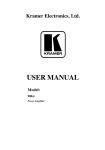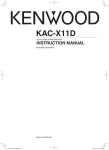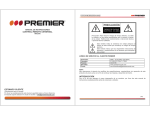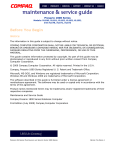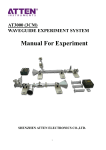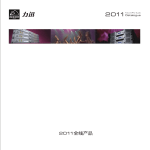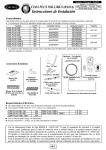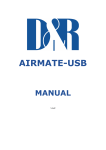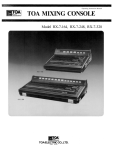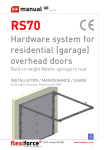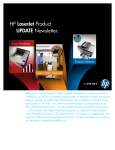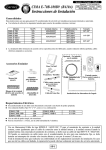Download Lanzar Speakers Installation Instructions
Transcript
USER’S MANUAL AMPLIFIERS: MAXP 1200 / 1055D / 1201D / 1601D / 2051D / 2055D / 2651D AMPLIFIER FEATUER DESCRIPTIONS ~I055D/~IZOID/~160ID ~IZOO ~Z05ID/~Z65ID/~Z055D o ~, ~. I. Une Out RCA Jacks· The LINE OUT allows you to build multiple amplifier systems without having to use splitter cords to distribute the signal. Now it is simple a matter of bringing one set of RCAs into the first amplifier, then using the line out RCA jacks as the feed to the next amplifier. 5. Brigde Mode 6. Variable Bass Boost Control· 0 - + 10dB Always use high quality shielded RCA cables. 3. Input Level Controls· Enables the matching of input levels to the output levels from the head unit! or other signal source). 4. Phase Shift· Allows you to change the phase of your subwoofer from 0 to 180 7. Variable Subsonic Filter· 15Hz-35Hz 8. Low Pass Filter· When Crossover Mode Selector is in Low Pass Mode, this control limits the frequencies which will be distributed to the speakers to those below the value to which this is set within the range 35Hz-250Hz. 9.Power & Protection Indicator.. Provde instant information on status of amplifier, including short-circuit and thermal overload alerts. degrees to help compensate for timing differences between drivers. 10. Balanced input: Accepts line level balanced input from 0.4v to Z. Line Input RCA .Jacks - These inputs are for signal cables from the source. 18v. Amplifier Feature Descriptions: BAlANCED INPUT: Accepts balanced line inputs from 0.4 volts to 18 volts. LINE INPUT: The Line Inputs are the RCA input jacks labeled "LINE INPUr. This is where the Radio/CD player RCA outputs connect to. The line Inputs accept unbalanced RCA inputs from 0.2 volts to 9 volts. UNE OUTPUT: The Line Outputs are a direct pass·through from the inputs. The RCA input signal from the radio/CD player is routed through the amplifier and out of the Line Outputs. The outputs would connect to another amp Line Inputs in a multi-amp set-up. This allows you to daisy chain multiple amps from a single set of RCA cables from the radio/CD player. LEVEL: The input level control allows you to match the amplifier input sensitivity to the output level of the RADIO/CD player from 0.2 Volts to 9 volts when using unbalanced RCA cables. The level control needs to be adjusted to match the line level Sensitivity fthis is the amount of voltage the radio/CD player RCA's provide. Example: If the radio/CD player Line level Sensitivity is 4 volts, adjust the amp level control to 4 volts SUBSONIC: The variable SubsoniC filter is for subwoofer applications that require very low tuning frequencies typically around 15Hz - 35Hz. BASS EQ: Variable Bass Boost from 0 to 1OdB at a fIXed 45Hz. LOW PASS: Fully adjustable crossover from 35 to 250Hz. PHASE SHIFT: The Phase Shift is fully adjustable from 0 to 180 degrees and this allows you to control the timing of the subwoofers. This is commonly used when the subwoofers are installed in each front door. SYSTEM DIAGNOSnCS: The amplifier has built-in monitoring devices and protection circuits that monitor all vital functions of the amplifier. The Protection light does not come on to indicate there is a failure, it comes on when it detects an improper operation. Common issues that cause. Protection status are: - THERMAL: The amp has an internal temperature sensor that will automatically shut off the amp if it reaches dangerous temperature levels. - OVER LOAD: If the amp is run at an improper impedance, the amp will shut down. If you are -CUPPING- speakers / subwooferfsJ, the light will blink to indicate a hard Clip. • DC PROTECT: In the unlikely event the amp should internally fail, the amp will shut down to prevent a DC voltage output to the speakers or sub. REMOTE: The Remote Module plugs into the Remotejack and allows you to adjust the level. MAXPI ZOO MONO BLOCK AMPLIFIER APPLICATIONS Basic application Interconnect cable checklist: - Connect the line inputs to a Radio/CD RCA outputs or line output of the full range primary amplifier with good quality RCA cables. A "Y" adapter may be needed as shown in the diagram. - Use at least 16 gauge speaker wiring. These amplifiers have dual speaker terminals, simplifying the hookup of multiple speakers Crossover frequency control checklist: - LOWPASS: 35Hz to 250Hz - SUBSONIC: 15Hz to 35Hz - BASS EO: 0 to 1OdB - PHASE: 0 to 180 degrees Level control checklist: - Refer to the section 'Setting up systems after installation for best performance- Minimum final loudspeaker impedance: - 1 ohm. /------------------, I FULL RANGE Dual Subwoofer Application I STEREO UNE INPUT Y-ADAPIOR ---C: 0 o ----+ ~ \ I NOT USED I ------------------~ *Note: You can use the Radio/CD designated mono line output or a full range stereo line output. For full range stereo line output, you will need an optional 'Y-Adaptor" as shown -_. -TOM.nmn'+I2V II CHAllIS GIIOWm ~PI055D/~PI201D/~PI601D/~P2051D/~P2651D ~P2055D MONO BLOCK CLASS D AMPLIFIER APPLICATIONS Basic application Interconnect cable checklist: - Connect the line inputs to a Radio/CD RCA outputs or line output of the full range primary amplifier with good quality RCA cables. A "Y" ada per may be needed as shown in the diagram. - Use at least 16 gauge speaker wiring. These amplifiers have dual speaker terminals, simplifYing the hookup of multiple speakers _0 8UBWOOFER nl!RBJU1I1! ."""'" a Crossover frequency control checklist: - lOWPASS: 35Hz to 250Hz - SUBSONIC: 15Hz to 35Hz - BASS EO: 0 to 10dB - PHASE: 0 to 180 degrees TOBATTERY+1JV w" .... "'CAR.,.... AUTO ANTENNA level control checklist: - Refer to the section ' Setting up systems after installation for best performance" Minimum final loudspeaker impedance: -I ohm. Dual Subwoofer Application , --------- ---------, I \ FULL RANGE STEREO LINE INPUT .... ........ ............ """""""'-....) -,-,-_ SUIIWOOFER -" I --c-- . 00 SUIIWOOFER = NOTUSED ---------'" *Note: You can use the Radio/CD designated mono line output or a full range stereo line output. For full range stereo line output, you will need an optional ny-Adaptor'" as shown ~ SETTING UP SYSTEMS AFTER INSTALLATION FOR BEST PERFORMANCE General: At this point you are ready to get more specific on the settings for your amplifier. Subsonic: This setting acts as a low frequency cut off for your system bass reproduction. The point that you set it at cuts off any frequencies from reproduction beyond this point. The 12 o'clock position is a great starting point. EXAMPLE: If you adjust the Subsonic to 25Hz, the amplifier will not play frequencies below 25Hz but will play frequencies from 25Hz to the chosen Low Pass frequency. 8assEQ: This setting is a fixed bass boost at 45Hz that is variable from 0- I OdB. This feature provides impact to your bass, but if not adjusted correctly, it can be over used and cause damage to your subwoofers and amplifiers. It is best to slowly turn this setting clockwise until the desired punch is felt. it is not recommended to exceed the 12 o'clock position unless listening at a low volume or a low recording quality as this can result in high distortion and possibly clipping. Low Pass: The Low pass control acts as a ceiling and doesn't allow frequencies to the right of the desired setting to be reproduced. The 12 o'clock position is a great starting point. EXAMPLE: If you adjust the Low Pass to BOHz, the amplifier will not play frequencies above 80Hz but will play frequencies from 80Hz to the chosen Subsonic frequency. Phase: The variable Phase adjustment allows you to change the relative time that the waveform meets your ear. With standard subwoofer installations where the subwoofer is behind you, the Phase should generally be at O. When subwoofers or woofers are in the kick panels or door panels, the Phase adjustment is useful in delaying the timing of the wave meeting your ear by adjusting the potentiometer to I BO degrees. LeveIIGAlNJ Control Setup: Ensure that the Level is turned completely to the left prior to turning the system on. Next you should insert a CD or cassette that you are familiar with to use as a reference, and turn the head unit volume control to about 80% of its full setting. The system sound level will of course be very low, and the following procedures will help you to match the amplifier input sensitivities properly to the head unit output signal level. It is important to match the amplifier LEVEL input sensitivity to the Radio/CD output sensitivity. This can be located in the Radio/CD manual. If the Radio/CD output sensitivity is 2 volts, then adjust the amplifier LEVEL input to 2 volts. If you are not sure what the Radio output sensitivity is, follow these general guide lines: Turn the level control up slowly, till you hear distortion, then back off a few degrees on the control. If at any point your amplifier goes into protection, you will need to turn the Level to the left a bit and then try again. If you reach a point where the output does not increase, stop turning the Level control to the right as the amplifier/subwoofer combo has reached its maxx output in this application. Lanzar MAX PRO SERIES AMPLIFIER FEATURES output Power Rating MAXPI200 MAXPIOSSD MAXPI20lD MAXPI60lD MAXP20SID MAXP205SD MAXP26SID 4Ohmload 2-Ohm load 450xl 900xl Ix250W lx500W Ix500W Ix 1OOOW Ix750W lx1500W lxl000W lx2000W lx625W lx1250W lx1250W lx2500W l-Ohm load O.S-Ohm load 1800xl NA lxl000W lx2000W lx2000W NA lx3000W NA lx4000W NA lx2500W lx5000W lx5000W NA YES >200 >95d8 <0.05% YES >300 >95dB <0.50% YES >300 >95dB <0.50% 0.2V-9V 0.04V- 18V 47k-Ohm YES >300 >95dB <0.50% 0.2V-9V 0.04V- 18V 47k-Ohm YES >300 >95dB <0.50% 0.2V-9V 0.04V- 18V 47k-Ohm 20k-Ohm Yes 20k-Ohm Electrical Specifications Slow Un-Mute Tum-On (soft start) Dampening Factor Signal To Noise Ratio (A-weighted) THD & Noise Variable Input level Controllunbalanced) Input Level Control ( balanced) Input Impedance (un-balanced) Input Impedance (balanced) Power / Diagnostic L.E.D. 0.2V-9V 0.2V-9V 0.04V- 18V 47k-Ohm 0.04V- 18V 47k-Ohm YES >300 >95dB <0.50% 0.2V-9V 0.04V- 18V 47k-Ohm 20k-Ohm 20k-Ohm 20k-Ohm Yes Yes Yes 20k-Ohm Yes Yes Yes Yes Yes Yes Yes Yes Yes Yes Yes Yes Yes 35Hz-250Hz 15Hz-35Hz OdB-+ 10dB Yes 35Hz-250Hz 15Hz-35Hz OdB - + 10dB Yes 35Hz-250Hz 15Hz-35Hz OdB-+ 10dB Yes Yes Yes Yes 12 gao 4ga. INCLUDED Yes Yes Yes 12 gao 4ga. INCLUDED 30Ax3 40Ax3 YES >300 >95dB <0.50% 0.2V-9V 0.04V- 18V 47k-Ohm 20k-Ohm Yes Yes Yes Yes Yes Yes Yes Yes Yes Yes Yes 35Hz-250Hz 15Hz-35Hz OdB - + 10dB Yes 35Hz-250Hz 15Hz-35Hz OdB-+ 10dB Yes 35Hz-250Hz 15Hz-35Hz OdB-+l0dB Yes 35Hz-250Hz 15Hz- 35Hz OdB-+ 10dB Yes Yes Yes Yes 12ga. 4ga. INCLUDED Yes Yes Yes 12 gao 4ga. INCLUDED Yes Yes Yes Oga. Oga. INCLUDED Yes Yes Yes Oga. Oga. INCLUDED Yes Yes Yes Oga. Oga. INCLUDED 35Ax3 40Ax4 200A (not included) 250A (not included) 250A (not included) Protection: DC. Speaker Short Thermal. Overload Power Supply MOSFET Audio Output MOSFET Crossover: Variable Low Pass Filter / 24dB Variable Subsonic Filter / 24dB Variable Bass EQ Phase Shift (0 - + 180 degrees) Cronnector Type: Unbalanced Inputs (RCA) Balanced Inputs (DIN) Line Output (RCA) Speaker Terminals (molded) Power/Ground Terminals (molded) Remote Fuses: Dimensions (W x H x L) Inches IO.16 x 25b xIO.9I W W W IO.16 x 2.56 x12.8 W W W TO.16 x 2.S6 xI2.BW W Note: All features sUbject to change without notice W IO.16 x 2.S6 xlS.6r W W w IO.16 x 2.S6 xla W w TO. 16 w w x 2.S6 x21.7r w w IO.16 x 2.S6 x2T.73 w TROUBLESHOOTING Before removing your amplifier, refer to the list below and follow the suggested procedures. Always test the speakers and their wires first. AMPLIFIER WILL NOT POWER UP. Check for good ground connection. Check that remote DC terminal has at least 13.Bv DC. Check that there is battery power on the +terminal. Check all fuses. Check that Protection lED is not lit. If it is lit shut off amplifier briefly and then repower it. HIGH HISS OR ENGINE NOISE (ALTERNATOR WHINE) IN SPEAKERS. Disconnect all RCA inputs to the amplifierlsJ.jf hiss/noise disappear>. then plug in the component driving the amplifier and unplug its inputs. If hiss / noise disappear>. go on until the faulty/noisy component is found. It is best to set the amplifier's input level as insensitive as possible. The best SUbjective SIN ratio is oblainable this way. Try to drive as high a signal level from the head unit as possible. PROTECTION LED COMES ON WHENtTHE AMPLIFIER IS POWERED UP. Check for shorts on speaker leads. Check that the volume control on the heiJd unit is turned down low. Remove speaker leads. and reset the am/Jlifier. If the P otection LED still comes on. then the amplifier is faulty. Check that the minimum speaker imped<lnce for that model is correct. Check for speaker shorts. Check that there is good airflow around the amplifier. In some applications, an external cooling fan may be required. DISTORTED SOUND Check that the level contrails) is set to match the signal Ie Check that all crossover frequencies have been properly set. LANZAR SPEAKERS SPEAKER SYSTEM











